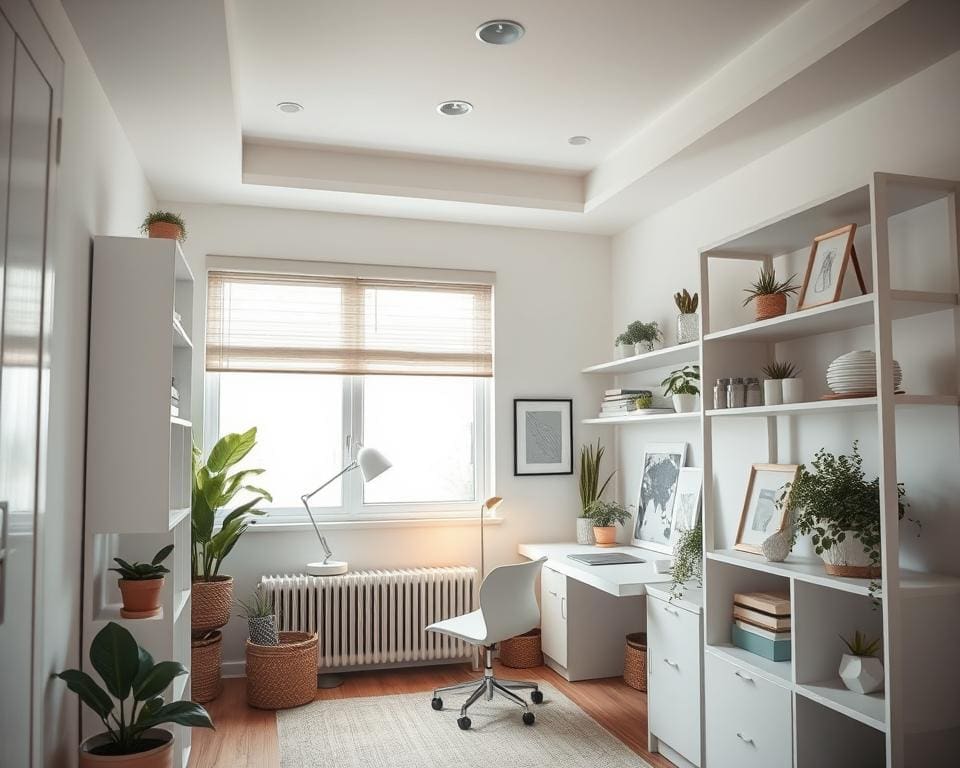In a world where remote working has become the norm, many individuals find themselves navigating the challenges of limited office space. How do you make a tiny workspace feel less cramped? This fundamental question addresses the need for maximising small office space to enhance productivity and well-being. An organised, efficient workspace not only promotes focus but also invites creativity. In this article, we will delve into various efficient small workspace solutions, encompassing decluttering strategies, innovative design ideas, and space-saving tips, all dedicated to transforming your compact area into a more open and functional haven.
Understanding the Challenges of a Small Workspace
Small workspace constraints can significantly hinder efficiency and creativity. The confines of limited office space often lead to productivity challenges, making it difficult for individuals to focus and thrive. Cramped environments create a sense of confinement that can increase stress levels and reduce overall job satisfaction.
Several factors amplify these issues. Poor organisation may leave essential items hidden, forcing workers to waste time searching for necessary tools. An ineffective layout can impede movement, leading to interruptions and distractions. Noise levels can rise in compact areas, further detracting from concentration.
Psychological factors play a crucial role in how individuals perceive their workspace. The feeling of being boxed in can lead to reduced motivation and creativity. Understanding these challenges is essential for addressing them effectively. By recognising the impact of small workspace constraints, one can begin to devise solutions that enhance productivity and create a more enjoyable work environment.

Effective Decluttering Strategies for a Small Office
Creating a productive environment in a small office often begins with effective decluttering techniques. When space is limited, every item must serve a purpose. Start by assessing your belongings, determining what is necessary and valuable. This process not only refreshes your workspace but also lays the groundwork for a more organised atmosphere.
Assess Your Belongings
Regularly evaluating items can significantly enhance your ability to declutter small office spaces. Begin with a simple ‘keep, toss, donate’ system. This method allows you to categorise each item based on its utility. Items you seldom use may belong in the toss or donate categories, while essentials remain accessible. This approach not only fosters a clearer workspace but also encourages thoughtful consumption.
Storage Solutions to Reduce Clutter
Incorporating efficient storage solutions is crucial in managing a small office effectively. Under-desk drawers provide a hidden space for stationery and documents, while wall-mounted shelves make use of vertical space, keeping your desk clear. Multifunctional furniture, such as a desk that doubles as a filing cabinet, can play a substantial role in clutter reduction methods, enabling you to maintain a neat and functional environment.
Space-Saving Tips for Optimising Your Office Layout
Making the most of a small workspace involves thoughtful planning and strategic choices. Implementing space-saving tips can greatly enhance your office layout, creating a more functional and inviting atmosphere. Selecting the right furniture plays a pivotal role in achieving this goal.
Furniture Selection for Maximum Space Efficiency
Opt for efficient furniture selection that complements your needs without overwhelming the space. Focus on compact desks that offer storage options or foldable chairs, allowing for quick adjustments. Consider furniture that can slide under tables when not in use, thus freeing up valuable floor space. Multi-functional pieces, such as desks that incorporate shelving or hidden compartments, allow for effective organisation and accessibility.
Using Vertical Space to Your Advantage
Incorporating vertical elements into your design can dramatically transform your office layout. Install shelves high on the walls to keep essentials accessible without obstructing movement. Pegboards and hooks can organise tools and supplies, creating a visually appealing setup while clearing desktop clutter. By utilising vertical space, you not only optimise the layout but also enhance the overall functionality of your working environment.
How do you make a tiny workspace feel less cramped?
The essence of a successful workspace transformation lies in creating an environment that exudes openness, even in limited square footage. To make a tiny workspace feel open, one must embrace several core principles. These principles include practical approaches that intertwine organisation and aesthetics.
Begin with decluttering, as a tidy space breeds clarity of thought and productivity. Evaluate your belongings and retain only those that serve a purpose or bring joy. Implement smart storage solutions, such as vertical shelving and multifunctional furniture, which help maximise your area while ensuring essentials are easily accessible. This not only streamlines your surroundings but plays a pivotal role in making the space feel more expansive.
Incorporating light, both natural and artificial, enhances the overall atmosphere. Use sheer curtains to allow sunlight to filter in, which visually expands the area. Mirrors positioned strategically can further reflect light, creating an illusion of depth. This thoughtful use of design elements transforms not just the look but the feel of your workspace.
Combining these strategies can significantly contribute to a refreshing workspace transformation. A holistic approach integrating decluttering, space-saving techniques, and thoughtful design does not merely improve aesthetics. It fosters an inviting and efficient workspace that encourages productivity and well-being.
Organising Your Compact Office Area
In the pursuit of an efficient workspace, a well-thought-out organisation strategy holds the key. Effectively organising a compact office area enhances productivity and comfort, transforming a small environment into a functional haven. The following systems provide practical approaches tailored specifically for limited spaces.
Functional Organisation Systems
Implementing effective organisation systems can drastically improve your workspace. Consider these methods to maximise your office’s potential:
- Categorised Storage: Group similar items together, such as stationery, documents, and supplies. This method simplifies finding what you need while maintaining a neat environment.
- Colour-Coded Files: Use a colour-coding system for different projects or documents. This visual method makes it easy to locate important files at a glance.
- Labelled Containers: Clearly label boxes and containers to avoid confusion. This simple practice not only aids in identifying contents but also encourages consistent organisation.
Daily Tidying Routines
Establishing daily tidying strategies plays a crucial role in maintaining an organised office. Simple routine steps can prevent clutter from accumulating:
- Set aside 5–10 minutes at the end of each day to review your workspace.
- Quickly sort through papers, removing what’s unnecessary and filing away what’s important.
- Ensure all items are returned to their designated places, promoting a tidy environment for the next day.
Embracing these practices fosters a sustainable atmosphere, ensuring that your compact office remains a well-organised space conducive to productivity.
Small Workspace Design Ideas to Enhance Openness
Creating a sense of space in a compact workstation can be achieved through thoughtful design choices. Small workspace design ideas often focus on colour schemes and strategic lighting techniques. Implementing these concepts can significantly enhance openness, making your environment feel more inviting and spacious.
Colour Schemes That Create Illusions of Space
Choosing the right colour scheme is essential in transforming your small workspace. Light-coloured paints, such as soft whites, pale blues, or gentle greens, reflect more light and visually expand the space. Consider these suggestions for optimal effect:
- Keep walls neutral: A consistent colour across walls creates a seamless look.
- Incorporate accents: Add subtle pops of colour through accessories or decor without overwhelming the space.
- Use large patterns sparingly: Minimalist designs on fabric or decor pieces can enhance openness without clutter.
Using Mirrors and Light Effectively
Mirrors serve as excellent visual space tricks. By reflecting light and multiplying the sense of depth, they can make a small area appear larger. Here are some tips on utilising mirrors and lighting:
- Position mirrors strategically: Place them opposite windows or light sources to capture and amplify natural light.
- Employ layered lighting: Use a mix of ambient, task, and accent lighting to create a dynamic and inviting atmosphere.
- Opt for sheer curtains: Allow natural light to filter through while maintaining privacy, which contributes to openness.
Incorporating Multi-Functional Furniture
In the quest to optimise a small workspace, incorporating multi-functional furniture proves invaluable. This approach seamlessly blends practicality with style while providing essential space-saving solutions. Choosing the right pieces can transform a cramped area into a functional hub, catering to various needs without overwhelming the space.
Desks That Double as Storage
When selecting practical office furniture, desks that offer built-in storage are a top choice. Models featuring cubbies, drawers, or shelves facilitate organisation while maintaining an uncluttered workspace. These desks not only serve as work surfaces but also provide ample room for documents, stationery, and other essentials. Investing in such designs ensures that every inch of your workspace works as hard as you do.
Foldable and Expandable Solutions
Foldable and expandable furniture options enhance flexibility in small offices. Compact tables that adjust in size offer significant advantages for those with fluctuating needs. They can transform from a simple writing desk into a larger table for collaboration when required. This versatility maximises space efficiency, allowing users to create a tailored working environment suitable for any task at hand.
The Role of Lighting in a Tiny Workspace
In a compact office environment, effective workspace lighting solutions significantly impact both functionality and mood. The right lighting can create an inviting atmosphere while enhancing productivity. Emphasising natural light benefits and strategic use of artificial lighting can transform a small space into a more open and invigorating area.
Natural Light Source Utilisation
Making the most of natural light can dramatically improve your workspace. Positioning desks near windows allows ample sunlight to pour in, creating a bright and airy feel. Sheer curtains can help filter light, providing a soft glow while maintaining privacy. Embracing the natural light benefits not only boosts your energy but fosters a positive working environment, making even the tiniest workspace feel more expansive.
Choosing the Right Artificial Lighting
When natural light is insufficient, effective artificial lighting becomes crucial. Opt for adjustable lamps that allow you to direct light where needed, ensuring your workspace remains adequately illuminated. LED options offer energy efficiency and longevity, making them a practical choice. Layered lighting, featuring overhead lights combined with task and accent fixtures, enhances versatility and comfort, paving the way for a more productive space.
Efficient Small Workspace Solutions for Productivity
Creating an efficient small workspace is essential for enhancing productivity and fostering a conducive work environment. By implementing the solutions discussed throughout this article, you can transform your compact office into a space that optimally supports your daily tasks. From effective decluttering strategies to strategic layout adjustments, every small change can contribute significantly to your overall performance.
Incorporating effective design elements into your workspace is vital for achieving productivity enhancement. Elements such as colour schemes that promote focus and utilising vertical space can create an atmosphere that inspires creativity. Adopting workspace efficiency tips like multi-functional furniture helps maximise the utility of every square inch, ensuring that your office remains both practical and aesthetically pleasing.
Ultimately, the key to creating an efficient small workspace lies in your ability to take actionable steps. Start by assessing your belongings and eliminating anything that doesn’t serve a purpose. By dedicating time to organisation and design, you will cultivate a workspace that not only minimises distractions but also fuels your motivation, leading to a satisfying and productive work experience.









